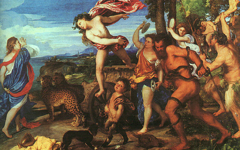Titian’s Danae (all versions)
I have never lost my sense of joy on seeing some form in significant art that has never been seen before. Forms are ideas and they change the meaning of an image in small or large ways and thus bring with them intense aesthetic satisfaction. Of course, many artists may have seen the form before me but most do not write about art so the "unseen form" remains unseen…often for centuries. Sometimes I can understand why the experts have missed these ideas. On other occasions there is no excuse at all. This is one of those occasions.

Titian, Danae with detail at right (c.1555-65) Oil on canvas. Kunsthistorisches Museum, Vienna
Click image to enlarge.
Titian painted three versions of Zeus impregnating Danae with a shower of gold. The one at left was the last. Along the top Zeus can be seen in profile, his features a little like the young Titian's. Experts, though, have failed to recognize that Titian is the creator god with Danae, long known to be based on a statue by Michelangelo, as his "work of art." In coupling with Danae, the artist's feminine reflection, Titian's androgynous and divine mind also conceives a new work.
Click next thumbnail to continue
In a version now in Madrid, dated two years earlier, the god in profile is missing but, in his place, far more poetically, Titian's bearded face can be seen emerging from the clouds or smoke, an image no writer has noted in over 500 years.
Click next thumbnail to continue

Left: Detail of Titian's Prado Danae; Center: Detail of Titian's Self-portrait inverted (early 1550's); Right: Diagram of Titian's face
Click image to enlarge.
For those who have trouble seeing it - and it is intentionally amorphous - the diagram will help. The brightest point in the clouds, the source of Zeus' divine power, is on the "forehead" right between Titian's two "eyes" as it is in his self-portrait too. There can be no doubt. This is a portrait of Titian as Zeus unseen by all art theorists and Titian specialists who, despite their erudition, had no idea what to look for. (Click on the image to enlarge it.)
Then on the next thumbnail to continue
In the original version Cupid's presence softens the violence of Zeus' rape while his arrows (none visible) symbolise Titian's brushes. (For examples of how arrows are "brushes", see Swords/Weapons as Brushes.) Thus, here, Danae and Zeus provide the conception of the artwork; Cupid the craft. Cupid must represent Titian in some manner because, once again, the artist's face - never before noted - is in Cupid's wing.
Click next thumbnail to continue

Left: Detail of Titian's Naples Danae; Center: Detail of Titian's Self-portrait inverted (early 1550's); Right: Diagram of Titian's face
Click image to enlarge.
Less legible than the face in the clouds Titian's likeness is suggested in feathers of varying colors above Cupid's right shoulder. The artist probably used another likeness of himself because this Danae pre-dates the self-portrait and his "face" is seen head-on. Nevertheless, given Titian's obvious presence in other versions as well as in two more by his assistants, his face must be in the feathers, just as you will find it hidden in other important images still to be discussed.
See conclusion below
Titian called these mythological paintings "poems", placing a high value on them. I have no doubt that they are full of profound wisdom, not found easily nor easily explained. It would be the kind of wisdom that only shines forth from a spiritual leader, a poet, shaman, oracle, prophet or artist. Art's ability to convey such esoteric meaning and an artist's power to grasp it is what, I believe, separates art from craft. For decades specialists on Titian believed that the Danae paintings did contain neo-Platonic ideas but, in an insult to their own subject, they thought that they must have been composed with the aid of a "better-educated" advisor. In recent years, other specialists now think that Titian was just painting erotic pictures for the Spanish king noting in support, once again, that Titian lacked a formal education and was unable to read Latin.1 Both approaches are off-target but, in light of so much blindness, that is hardly surprising.
More Works by Titian
Notes:
1. Thomas Puttfarken, Titian and Tragic Painting: Aristotle's Poetics and the Rise of the Modern Artist (New Haven: Yale University Press) 2005, p. 147. I should add that Puttfarken himself expresses doubt about both views noting that from "intellectual over-interpretation" they have gone too far in the opposite direction.
Original Publication Date on EPPH: 08 Feb 2012. | Updated: 0. © Simon Abrahams. Articles on this site are the copyright of Simon Abrahams. To use copyrighted material in print or other media for purposes beyond 'fair use', you must obtain permission from the copyright owner. Websites may link to this page without permission (please do) but may not reproduce the material on their own site without crediting Simon Abrahams and EPPH.





